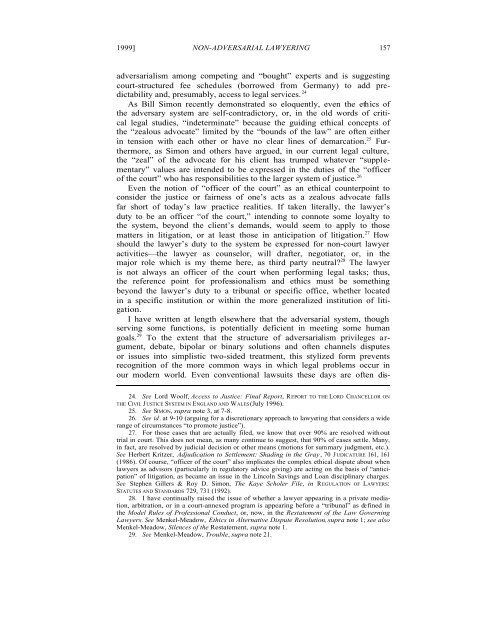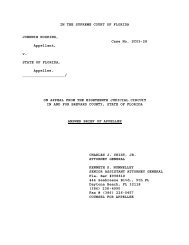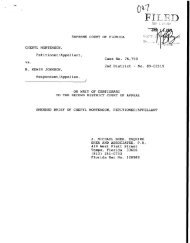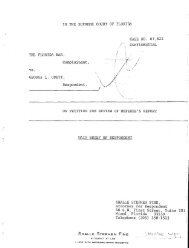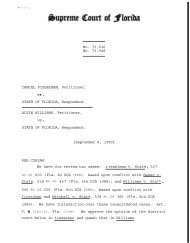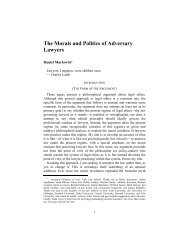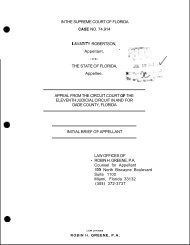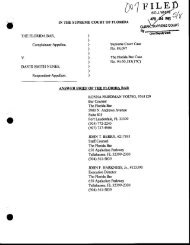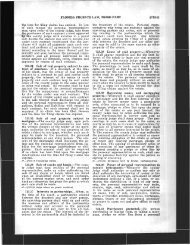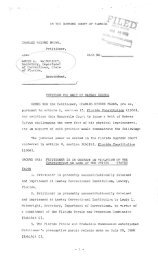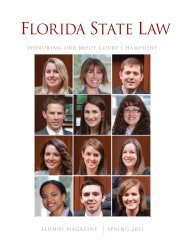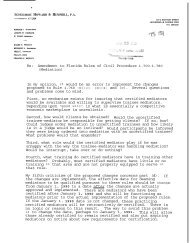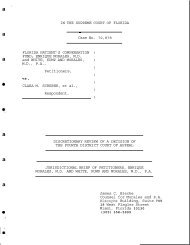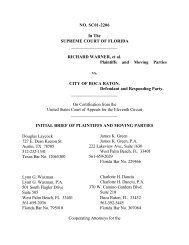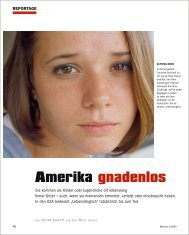ethics and professionalism in non- adversarial lawyering
ethics and professionalism in non- adversarial lawyering
ethics and professionalism in non- adversarial lawyering
Create successful ePaper yourself
Turn your PDF publications into a flip-book with our unique Google optimized e-Paper software.
1999] NON-ADVERSARIAL LAWYERING 157<br />
<strong>adversarial</strong>ism among compet<strong>in</strong>g <strong>and</strong> “bought” experts <strong>and</strong> is suggest<strong>in</strong>g<br />
court-structured fee schedules (borrowed from Germany) to add predictability<br />
<strong>and</strong>, presumably, access to legal services. 24<br />
As Bill Simon recently demonstrated so eloquently, even the <strong>ethics</strong> of<br />
the adversary system are self-contradictory, or, <strong>in</strong> the old words of critical<br />
legal studies, “<strong>in</strong>determ<strong>in</strong>ate” because the guid<strong>in</strong>g ethical concepts of<br />
the “zealous advocate” limited by the “bounds of the law” are often either<br />
<strong>in</strong> tension with each other or have no clear l<strong>in</strong>es of demarcation. 25 Furthermore,<br />
as Simon <strong>and</strong> others have argued, <strong>in</strong> our current legal culture,<br />
the “zeal” of the advocate for his client has trumped whatever “supplementary”<br />
values are <strong>in</strong>tended to be expressed <strong>in</strong> the duties of the “officer<br />
of the court” who has responsibilities to the larger system of justice. 26<br />
Even the notion of “officer of the court” as an ethical counterpo<strong>in</strong>t to<br />
consider the justice or fairness of one’s acts as a zealous advocate falls<br />
far short of today’s law practice realities. If taken literally, the lawyer’s<br />
duty to be an officer “of the court,” <strong>in</strong>tend<strong>in</strong>g to connote some loyalty to<br />
the system, beyond the client’s dem<strong>and</strong>s, would seem to apply to those<br />
matters <strong>in</strong> litigation, or at least those <strong>in</strong> anticipation of litigation. 27 How<br />
should the lawyer’s duty to the system be expressed for <strong>non</strong>-court lawyer<br />
activities—the lawyer as counselor, will drafter, negotiator, or, <strong>in</strong> the<br />
major role which is my theme here, as third party neutral? 28 The lawyer<br />
is not always an officer of the court when perform<strong>in</strong>g legal tasks; thus,<br />
the reference po<strong>in</strong>t for <strong>professionalism</strong> <strong>and</strong> <strong>ethics</strong> must be someth<strong>in</strong>g<br />
beyond the lawyer’s duty to a tribunal or specific office, whether located<br />
<strong>in</strong> a specific <strong>in</strong>stitution or with<strong>in</strong> the more generalized <strong>in</strong>stitution of litigation.<br />
I have written at length elsewhere that the <strong>adversarial</strong> system, though<br />
serv<strong>in</strong>g some functions, is potentially deficient <strong>in</strong> meet<strong>in</strong>g some human<br />
goals. 29 To the extent that the structure of <strong>adversarial</strong>ism privileges argument,<br />
debate, bipolar or b<strong>in</strong>ary solutions <strong>and</strong> often channels disputes<br />
or issues <strong>in</strong>to simplistic two-sided treatment, this stylized form prevents<br />
recognition of the more common ways <strong>in</strong> which legal problems occur <strong>in</strong><br />
our modern world. Even conventional lawsuits these days are often dis-<br />
24. See Lord Woolf, Access to Justice: F<strong>in</strong>al Report, REPORT TO THE LORD CHANCELLOR ON<br />
THE CIVIL J USTICE SYSTEM IN ENGLAND AND WALES (July 1996).<br />
25. See SIMON, supra note 3, at 7-8.<br />
26. See id. at 9-10 (argu<strong>in</strong>g for a discretionary approach to lawyer<strong>in</strong>g that considers a wide<br />
range of circumstances “to promote justice”).<br />
27. For those cases that are actually filed, we know that over 90% are resolved without<br />
trial <strong>in</strong> court. This does not mean, as many cont<strong>in</strong>ue to suggest, that 90% of cases settle. Many,<br />
<strong>in</strong> fact, are resolved by judicial decision or other means (motions for summary judgment, etc.).<br />
See Herbert Kritzer, Adjudication to Settlement: Shad<strong>in</strong>g <strong>in</strong> the Gray, 70 JUDICATURE 161, 161<br />
(1986). Of course, “officer of the court” also implicates the complex ethical dispute about when<br />
lawyers as advisors (particularly <strong>in</strong> regulatory advice giv<strong>in</strong>g) are act<strong>in</strong>g on the basis of “anticipation”<br />
of litigation, as became an issue <strong>in</strong> the L<strong>in</strong>coln Sav<strong>in</strong>gs <strong>and</strong> Loan discipl<strong>in</strong>ary charges.<br />
See Stephen Gillers & Roy D. Simon, The Kaye Scholer File, <strong>in</strong> REGULATION OF LAWYERS:<br />
STATUTES AND STANDARDS 729, 731 (1992).<br />
28. I have cont<strong>in</strong>ually raised the issue of whether a lawyer appear<strong>in</strong>g <strong>in</strong> a private mediation,<br />
arbitration, or <strong>in</strong> a court-annexed program is appear<strong>in</strong>g before a “tribunal” as def<strong>in</strong>ed <strong>in</strong><br />
the Model Rules of Professional Conduct, or, now, <strong>in</strong> the Restatement of the Law Govern<strong>in</strong>g<br />
Lawyers. See Menkel-Meadow, Ethics <strong>in</strong> Alternative Dispute Resolution, supra note 1; see also<br />
Menkel-Meadow, Silences of the Restatement, supra note 1.<br />
29. See Menkel-Meadow, Trouble, supra note 21.


